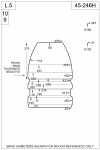Of all the 45acp pistols I have loaded for, the SIGs were the most finicky regarding bullet shape and cartridge OAL.
Sig 45s were #2 for me. Number 1 was one of those custom Luger conversions I got to play with for a few weeks: it was almost 100% with ammo it liked, but change
anything and it was a jam-o-matic. Neat gun though.
My question is... why the draw to heavier than norm chunks of lead in a 45?? Competition? Bowling pin? Fun?
In my case, I wanted a 45 for a field gun. My experience at the time was that 1911s tended to be more accurate than revolvers (probably due to cylinder dimensions) (or maybe I just shot them better). I started by getting interested in trying to increase the length of bearing surface over Lyman's 452374 (I didnt understand how to address the skidding I saw on recovered bullets).
First try was a nominally-230gr truncated cone. These solved the skidding problems (more likely, an alloy change solved the skidding problems) and improved accuracy. Then I went to SWC (452423 and 454424), then played with some 300 grain bullets for the 45-90 sized down to .452. (Great accuracy, but it gave new meaning to "rainbow trajectory" due to the very low velocity.)
As a field pistol, the truncated cone was probably the most-significant improvement. This load (slightly over standard velocity) is what I used on that bear that so rudely barged into the tent and woke me up. The 452423 load was what I carried doing a bunch of biological survey work. If I were going to pick a close-to-standard velocity load it would be this bullet at ~850fps. Accuracy was acceptable out to 100 yards or so, and penetration was better than the 200gr SWC.
Second choice would be the 230 TC at about the same velocity. This load did work in my friend's 220, BTW.
The 45 Super work was to see if the concept was as good as it seemed. I still think it is the best CF auto pistol cartridge for field use.

